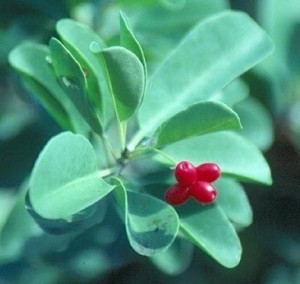Guapira discolor: A Blolly by Golly
The Blolly confounded me when I first saw the tree for it was growing by itself in a park. The fruit is quite distinct, a red cylinder with a dimple at the end. I thought I could identify it quickly but didn’t. Then, as often happens, I was looking for something else and identified it.
This tree has long been associated with White Crowned Pigeons, particularly capturing them. Apparently they favor the berries and is their second most common food throughout the year; fig berries are dominate part of the year and Poisonwood berries the rest of the year. Tanagers, catbirds, warblers… and Iguanas like them, too. The tree’s twigs, which are strong and flexible, were used to make wattle. That’s when you fill a frame with a lattice then mud it in. Called Wattle and Daub, it’s a construction technique at least 6,000 years old and still in use in many parts of the world. Wattle and Daub making a comeback because it’s “sustainable.”
One little confusing aspect about the fruit is that it is faintly ribbed and has 10 ribs. But, you would not notice them if they weren’t pointed out to you. They usually are not obvious. Some writers mention them, some don’t.
Botanically, the Blolly is Guapira discolor (gwah-PEER-uh DIS-kol-or.) Guapira is a combination of two native words usually given as wa’bi rob which sounds closer than it looks. They mean “to eat bitter.” Discolor means two colors, which the leaves have. Blolly is from an English word, loblolly, which refers to thickets growing in moist depressions. Blolly means thicket after its characteristic growth habit.
Green Deane’s “Itemized” Plant Profile
IDENTIFICATION:
A shrub or sometimes a tree to 40 feet, tallest known is 55 feet; compact, round crown, with many crooked trunks, leaves opposite or alternate, elliptical to obvate, light green in color, leathery simple, one to two inches long, one half to and inch wide, wavy edge, rounded or notched at the end, on slender stalks, grooved. Veins are obscure except for the central vein which is yellowish green and translucent when held up to the light. Leaves start thin and thicken. Flowers funnel shaped, lacking petals, to a half inch long. Fruit,slender, oval, juicy, half inch long, red, 10-ribbed, one tan cylindrical seed.
TIME OF YEAR:
Summer and fall, farther south all year
ENVIRONMENT:
Hammocks, coastal shrub, pine lands, landscaping, mid-state south. Very common in Miami and the Cayman Islands. In the topics the tree is often covered with a green lichen.
METHOD OF PREPARATION:
Ripe fruit out of hand.



